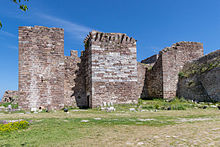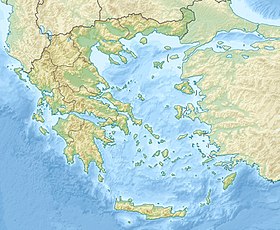| Ottoman conquest of Lesbos | |||||||||
|---|---|---|---|---|---|---|---|---|---|
| Part of the Expansion of the Ottoman Empire in Europe | |||||||||
 Towers of the Castle of Mytilene | |||||||||
| |||||||||
| Belligerents | |||||||||
| Knights Hospitaller | Ottoman Empire | ||||||||
| Commanders and leaders | |||||||||
|
Niccolò Gattilusio Luchino Gattilusio |
Mehmed the Conqueror Mahmud Angelović | ||||||||
| Strength | |||||||||
|
| ||||||||
Location of Mytilene and Lesbos within Greece | |||||||||
The Ottoman conquest of Lesbos took place in September 1462. The Ottoman Empire, under Sultan Mehmed II, laid siege to the island's capital, Mytilene. After its surrender, the other forts of the island surrendered as well. The event put an end to the semi-independent Genoese lordship that the Gattilusio family had established in the northeastern Aegean since the mid-14th century, and heralded the beginning of the First Ottoman–Venetian War in the following year.
In the mid-14th century, the Gattilusio family had established an autonomous lordship under Byzantine suzerainty on Lesbos. By 1453, the Gattilusio domains had come to include most of the islands in the northeastern Aegean. In the aftermath of the fall of the Byzantine Empire in 1453, however, Mehmed II began reducing the Gattilusio holdings. By the end of 1456, only Lesbos remained in Gattilusio hands, in exchange for an annual tribute to the Sultan. In 1458 Niccolò Gattilusio seized control of the island from his brother, and began preparing for an eventual Ottoman attack. Despite his appeals, however, no help was forthcoming from other Western powers. Mehmed II began his campaign against Lesbos in August 1462, and the Ottomans landed on the island on 1 September. After a few days of skirmishing, the Ottomans brought up their artillery and began bombarding the Castle of Mytilene. By the eighth day, the Ottomans had captured the harbour fortifications, and two days later, they seized the lower town of Melanoudion. At this point, panic set in among the defenders, and their will to continue resisting collapsed.
Niccolò Gattilusio surrendered the castle and the rest of the island on 15 September, on promises of receiving estates of equivalent value. He was taken to Constantinople, where he was soon strangled. Despite promises, many of the defenders were executed, and a large part of the inhabitants were carried off as slaves, as servants in the Sultan's palace, or to help repopulate Constantinople. Ottoman rule on Lesbos lasted, with minor interruptions, until 1912.
- ^ Babinger 1978, p. 211.
